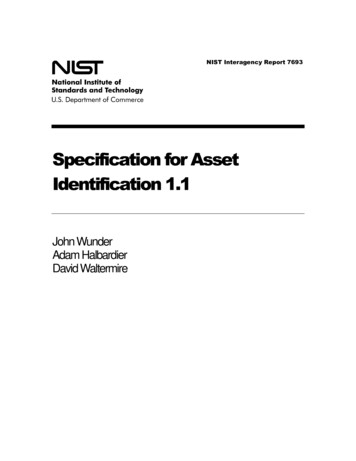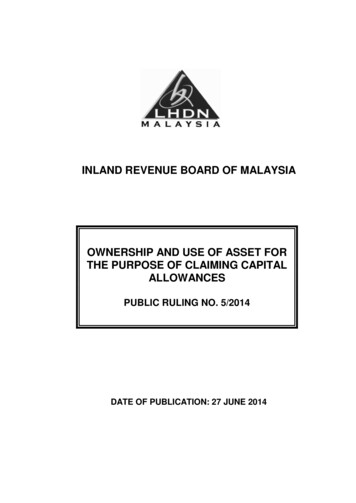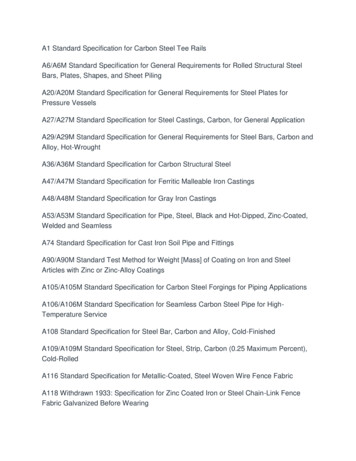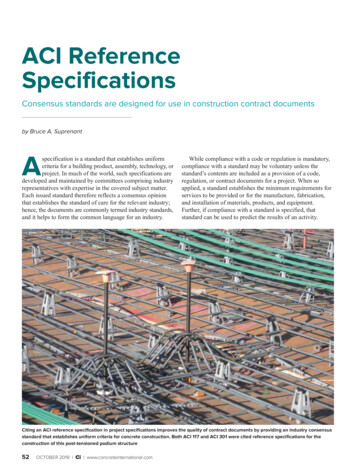
Transcription
NIST Interagency Report 7693Specification for AssetIdentification 1.1John WunderAdam HalbardierDavid Waltermire
Specification for Asset Identification 1.1NIST Interagency Report 7693John WunderAdam HalbardierDavid WaltermireC O M P U T E RS E C U R I T YComputer Security DivisionInformation Technology LaboratoryNational Institute of Standards and TechnologyGaithersburg, MD 20899-8930June 2011U.S. Department of CommerceGary Locke, SecretaryNational Institute of Standards and TechnologyDr. Patrick D. Gallagher, Director
SPECIFICATION FOR ASSET IDENTIFICATION 1.1Reports on Computer Systems TechnologyThe Information Technology Laboratory (ITL) at the National Institute of Standards and Technology(NIST) promotes the U.S. economy and public welfare by providing technical leadership for the nation‟smeasurement and standards infrastructure. ITL develops tests, test methods, reference data, proof ofconcept implementations, and technical analysis to advance the development and productive use ofinformation technology. ITL‟s responsibilities include the development of technical, physical,administrative, and management standards and guidelines for the cost-effective security and privacy ofsensitive unclassified information in Federal computer systems. This Interagency Report discusses ITL‟sresearch, guidance, and outreach efforts in computer security and its collaborative activities with industry,government, and academic organizations.National Institute of Standards and Technology Interagency Report 769336 pages (June 2011)Certain commercial entities, equipment, or materials may be identified in thisdocument in order to describe an experimental procedure or concept adequately.Such identification is not intended to imply recommendation or endorsement by theNational Institute of Standards and Technology, nor is it intended to imply that theentities, materials, or equipment are necessarily the best available for the purpose.ii
SPECIFICATION FOR ASSET IDENTIFICATION 1.1AcknowledgmentsThe authors, John Wunder of The MITRE Corporation, Adam Halbardier of Booz Allen Hamilton, andDavid Waltermire of the National Institute of Standards and Technology (NIST) wish to thank theircolleagues who reviewed drafts of this document and contributed to its technical content. The authorswould like to acknowledge Paul Cichonski and Harold Booth of NIST, Karen Scarfone of ScarfoneCybersecurity, Joseph Wolfkiel of the Defense Information Systems Agency (DISA), Jim Ronayne ofVaren Technologies, Gary Newman of Belarc, Gerard McGuire of The MITRE Corporation, and MarkJohnson of Booz Allen Hamilton for their keen and insightful assistance throughout the development ofthe document.AbstractAsset identification plays an important role in an organization‟s ability to quickly correlate different setsof information about assets. This specification provides the necessary constructs to uniquely identifyassets based on known identifiers and/or known information about the assets. This specification describesthe purpose of asset identification, a data model for identifying assets, methods for identifying assets, andguidance on how to use asset identification. It also identifies a number of known use cases for assetidentification.Trademark InformationCPE is a trademark of The MITRE Corporation.All other registered trademarks or trademarks belong to their respective organizations.iii
SPECIFICATION FOR ASSET IDENTIFICATION 1.1Table of Contents1.Introduction . 11.11.21.31.42.Purpose and Scope . 1Audience . 2Document Structure . 2Document Conventions . 2Terms and Abbreviations . 32.12.2Terms . 3Acronyms . 43.Relationship to Existing Standards and Specifications . 54.Conformance . 64.15.Asset Identification Overview . 75.15.25.35.45.55.65.76.Product Conformance. 64.1.1 Consumers. 64.1.2 Producers. 6Scope . 7Core Specification and Extension Points . 7Data Model Overview . 75.3.1 Literal Identifiers . 85.3.2 Synthetic Identifiers . 85.3.3 Relationship Identifiers . 85.3.4 Extension Identifiers . 9Providing Asset Identifications . 9Consuming Asset Identifications . 9Matching. 9Sample Correlation Workflow . 9Data Model .126.16.26.36.46.5Abstract Elements . 12Concrete Asset Elements . 13Helper Elements . 18Relating Assets to Other Assets . 216.4.1 Relationship Data Model .216.4.2 Relationship Types.23Guidance for Incorporating Asset Identification Elements into Other Data Models . 25Appendix A— Use Cases.26A.1A.2A.3A.4Correlation of Sensed Data . 26Federation of Asset Databases . 26Directly Targeted Remediation Actions . 26Management of Asset Data . 27Appendix B— Extending the Asset Identification Specification.28B.1 Additional Asset Types . 28B.2 Additional Literal Identifiers for Existing Asset Types . 28B.3 Additional Relationships . 28iv
SPECIFICATION FOR ASSET IDENTIFICATION 1.1B.4 Additional Properties on Existing Data Elements . 28Appendix C— Normative References .29List of FiguresFigure 5-1: Sample Correlation Workflow .10List of TablesTable 1-1: Conventional XML Mappings. 2Table 6-1: Element – ai:asset.13Table 6-2: Element – ai:it-asset.13Table 6-3: Element – ai:circuit .13Table 6-4: Element – ai:computing-device .14Table 6-5: Element – ai:data .14Table 6-6: Element – ai:database.14Table 6-7: Element – ai:network .15Table 6-8: Element – ai:organization .15Table 6-9: Element – ai:person .16Table 6-10: Element – ai:service .16Table 6-11: Element – ai:software .17Table 6-12: Element – ai:system .17Table 6-13: Element – ai:website .17Table 6-14: Element – ai:synthetic-id .18Table 6-15: Element – ai:connections .18Table 6-16: Element – ai:connection .18Table 6-17: Element – ai:locations .19Table 6-18: Element – ai:location-point .19Table 6-19: Element – ai:location-region .20Table 6-20: Element – ai:ip-net-range .20Table 6-21: Element – ai:ip-address.20Table 6-22: Element – ai:port-range .20Table 6-23: Element – ai:host .21Table 6-24: Element – ai:cpe .21v
SPECIFICATION FOR ASSET IDENTIFICATION 1.1Table 6-25: Element – ai:asset-related .22Table 6-26: Element – ai:assets .22Table 6-27: Element – core:relationships .22Table 6-28: Element – core:relationship .23Table 6-29: Controlled Vocabulary Defined for Asset Identification .24vi
SPECIFICATION FOR ASSET IDENTIFICATION 1.11.IntroductionOne of the primary requirements for performing asset management is the ability to identify assets basedon some set of data known about them. Asset identification, the use of attributes and methods to uniquelyidentify an asset, allows for correlation of data across multiple sources, reporting of asset informationacross different organizations and databases, targeted actions against specific assets, and usage of assetdata in other business processes.Unfortunately, neither a unified method nor a published specification for performing asset identificationexists at this time. Existing security automation specifications either do not consider asset identification orrepresent identification information differently than other specifications with which they interoperate.This means that correlation of data relies on a transformation process between each specification, which isexpensive and unreliable. Creation of such a unified method and specification for performing assetidentification would allow for greater interoperability, increased capabilities, and easier implementationof asset management processes.This Asset Identification specification describes a framework for how asset management processes andother specifications may identify assets using some set of information known or generated about the asset.It describes the data model and representation of asset identification information and it providesrequirements for consuming and producing identification information. Requirements for usage of assetinformation and requirements for how the information that identifies assets is collected or generated areout of scope for this specification.For the purposes of this specification, an asset is considered to be anything that has value to anorganization. For example, computing devices are one form of asset that many organizations track. Thisspecification, however, does not limit asset identification to identifying computing devices; any type ofasset may be identified. The specification itself provides constructs for identifying many types of assets,and users may extend the model to include other asset types if they wish to identify asset types that arenot addressed in the specification.It is expected that other standards, data formats, tools, processes, and organizations will reference thisspecification to describe how to represent asset identification information. This will ensure compatibilityof asset identifications among these components and allow for improved asset management processes.While this specification was developed to support the immediate needs of the security automationcommunity, it is expected that it will be valuable in general asset management processes both inside andoutside of the security automation space.1.1Purpose and ScopeThe purpose of this document is to define the Asset Identification specification, a standardized model forrepresenting and identifying assets.The scope of this document is to give an introduction to Asset Identification, give guidelines on usingAsset Identification, describe the Asset Identification data model, and document conformancerequirements to comply with Asset Identification. Other versions of Asset Identification and theassociated component specifications, including emerging specifications and future versions, are notaddressed here.Future versions of Asset Identification will be defined in distinct revisions of this document, each clearlylabeled with a document revision number and the appropriate Asset Identification version number.1
SPECIFICATION FOR ASSET IDENTIFICATION 1.11.2AudienceThis specification is intended for authors of specifications that must support asset identifications,implementers of those specifications, system integrators composing architectures from tools thatimplement those specifications, and end users who wish to understand how these tools work.1.3Document StructureThe remainder of this document is organized into the following major sections: Section 2 defines the terms used within this specification and provides a list of commonabbreviations. Section 3 describes how this specification fits with related standards and specifications. Section 4 defines the conformance requirements for asset identification. Section 5 gives an overview of asset identification. Section 6 describes the asset identification data model constructs. Appendix A describes possible use cases for asset identification. Appendix B explains how the specification can be extended. Appendix C documents the normative references for this specification1.4Document ConventionsThroughout this specification, whenever a specific term from the data model is referenced, as defined inSection 6, the term is written in Courier New font. When referencing a specification listed inAppendix B, the name will be written between brackets, such as [XML Schema].The key words “MUST”, “MUST NOT”, “REQUIRED”, “SHALL”, “SHALL NOT”, “SHOULD”,“SHOULD NOT”, “RECOMMENDED”, “MAY”, and “OPTIONAL” in this document are to beinterpreted as described in [RFC 2119].Both inline and indented forms use qualified names to refer to specific XML elements. A qualified nameassociates a named element with a namespace. The namespace identifies the specific XML schema thatdefines (and consequently may be used to validate) the syntax of the element instance. A qualified namedeclares this schema to element association using the format „prefix:element-name‟. The association ofprefix to namespace is defined in the metadata of an XML document and generally will vary fromdocument to document. In this specification, the conventional mappings listed in Table 1-1 are used.Table 1-1: Conventional XML MappingsMappings PrefixNamespace ification/1.1Asset Identification ng-core/1.1http://cpe.mitre.org/naming/2.0SCAP Reporting Core 1.1CPE 2.3 Naming ASIS extensible Address LanguageOASIS extensible Name Language2
SPECIFICATION FOR ASSET IDENTIFICATION 1.12.Terms and Abbreviations2.1TermsThis section defines a set of common terms used within the document.Asset: Anything that has value to an organization, including, but not limited to, another organization,person, computing device, information technology (IT) system, IT network, IT circuit, software (both aninstalled instance and a physical instance), virtual computing platform (common in cloud and virtualizedcomputing), and related hardware (e.g., locks, cabinets, keyboards).Asset Identification: The use of attributes and methods to uniquely identify an asset.Asset Identification Element: A complete, bound expression of an asset identification using theconstructs defined in this specification.Circuit: A dedicated single connection between two endpoints on a network.Computing Device: A machine (real or virtual) for performing calculations automatically (including, butnot limited to, computer, servers, routers, switches, etc.)Data: Any piece of information suitable for use in a computer.Database: A repository of information or data, which may or may not be a traditional relational databasesystem.Extension Identifier: Any piece of identifying information provided in an asset identification elementthat is not explicitly defined in the Asset Identification schema.Identifying Information: The set of an asset‟s attributes that may be useful for identifying that asset,including discoverable information about the asset and identifiers assigned to the asset.Matching: The process of determining whether two or more asset identification expressions refer to thesame asset.Network: An information system(s) implemented with a collection of interconnected components. Suchcomponents may include routers, hubs, cabling, telecommunications controllers, key distribution centers,and technical control devices.Organization: An entity of any size, complexity, or positioning within an organizational structure (e.g., afederal agency, or, as appropriate, any of its operational elements).Person: Any person considered as an asset by the management domain.Relationship Identifier: Identifying information where the value is a relationship to another asset.Service: A set of related IT components provided in support of one or more business processes.Software: Computer programs and associated data that may be dynamically written or modified duringexecution.3
SPECIFICATION FOR ASSET IDENTIFICATION 1.1System: A discrete set of information resources organized for the collection, processing, maintenance,use, sharing, dissemination, or disposition of information.Synthetic Identifier: An identifier that is assigned to an asset in the context of some managementdomain.Website: A set of related web pages that are prepared and maintained as a collection in support of asingle ITLMACNISTOASISRFCURIURLW3CWFNxALXMLxNLXSDBasic Input/Output SystemClassless Inter-Domain RoutingCommon Platform EnumerationFully-Qualified Domain NameGlobally Unique IdentifierHypertext Transfer ProtocolInternet Engineering Task ForceInternet ProtocolInformation TechnologyInformation Technology LaboratoryMedia Access ControlNational Institute of Standards and TechnologyOrganization for the Advancement of Structured Information StandardsRequest for CommentUniform Resource IdentifierUniform Resource LocatorWorld Wide Web ConsortiumWell-Formed Nameextensible Address LanguageExtensible Markup Languageextensible Naming LanguageXML Schema4
SPECIFICATION FOR ASSET IDENTIFICATION 1.13.Relationship to Existing Standards and SpecificationsThis specification defines the constructs and methods for representing asset identification information andthus can be leveraged by any other specification where identifying assets is required or beneficial.This specification uses several industry-standard mechanisms for representing identification informationand providing conformance requirements.Common Platform Enumeration (CPE) is a structured naming scheme for information technologysystems, platforms, and packages. Based upon the generic syntax for Uniform Resource Identifiers (URI),CPE includes a formal name format. CPE version 2.3 Well-Formed Names (WFN) are used as softwareidentifying information by this specification.The extensible Address Language (xAL) by the Organization for the Advancement of StructuredInformation Standards (OASIS) is an XML standard format for representing international addressinformation. Asset Identification leverages xAL to represent address information for assets.The extensible Name Language (xNL) by OASIS is an XML standard format for representing the namesof people and organizations. Asset Identification leverages xNL to represent the names of people andorganizations.5
SPECIFICATION FOR ASSET IDENTIFICATION 1.14.ConformanceA product may want to claim conformance with this specification so that users and organizations can usethe product with the assurance that the product can identify assets in a consistent and standard manner.The ability for a product to identify assets in a standard manner increases the likelihood of interoperabilitybetween conforming products. This section defines the criteria for products to claim conformance withthis specification.4.1Product ConformanceProducts are divided into two roles based on their use of asset identification information: consumers andproducers. Consuming products (“consumers”) must be able to receive and understand information incompliance with this specification.Producing products (“producers”) must create asset identification information in a formatcompliant with this specification.A product may be both a consumer and producer. The following subsections document the conformancerequirements for the two types of products.4.1.1ConsumersAny consuming product claiming conformance to this specification MUST adhere to the followingrequirements. 4.1.2The consumer SHALL be capable of processing the identification information represented inconstructs consistent with the Asset Identification data model without error. REF: Section 6The consumer MAY attempt to consume constructs that are invalid per the Asset Identificationdata model. REF: Section 6The consumer MAY consume extension identifiers and use them as an input into a matchingprocess. REF: Section 5.3.4The consumer MUST NOT abnormally end, crash, or otherwise be unable to fully process assetidentification elements that include extension identifiers. It MAY ignore any information inextension identifiers.ProducersAny producing product claiming conformance to this specification MUST adhere to the followingrequirements. The producer SHALL accurately produce the asset identification element in XML consistent withthe data model. REF: Section 6When representing identification information, the producer SHOULD provide as muchinformation as is sufficient to allow for a match. REF: Section 5.3When representing identification information, the producer MAY provide as much or as littleidentifying information as allowed in the data model per other recommendations or toolcapabilities. REF: Section 5.3The producer MAY provide extension identifiers for any asset identification element. REF:Section 5.3.46
SPECIFICATION FOR ASSET IDENTIFICATION 1.15.Asset Identification OverviewThis section gives an overview of the Asset Identification specification and its key concepts.5.1ScopeIn order to support the variety of use cases discussed in Appendix A, the scope of this specification islimited to a description of how asset management tools can represent asset identification informationwhen communicating it to other tools. It is out of scope of this specification to recommend whichidentifiers to use or to require that identification information be collected in a certain way or from acertain place. Higher-level specifications, tools, and organizations that implement Asset Identification,however, are encouraged to make these recommendations or specify these requirements in order tosupport the particular needs of their use cases.Additionally, the Asset Identification specification is not a mechanism for expressing information aboutan asset that is not related to asset identification. Only elements that are used for identification areincluded in the core specification. Asset Identification elements MUST NOT be used to representinformation about an asset unless it is being used to identify that asset.5.2Core Specification and Extension PointsThe core Asset Identification specification defines eleven asset types and definitions of how those assettypes may be identified using a set of literal attributes and relationships to other assets. The corespecification is intended to provide definitions for commonly used asset types and identificationattributes; it is not intended to be an exhaustive list of all possible asset types and attributes that may beused for identification. Anything explicitly defined in the asset identification schema and the assetidentification controlled vocabulary for relationship identifiers is considered part of the core specification.There are several extension points in the Asset Identification data model to allow for identification ofasset types beyond what is included in the core specification and to allow attributes or relationshipsoutside of the core specification to be used to identify asset types that are included. These extensionpoints are: 5.3Additional asset types may be created by inheriting from any concrete or abstract “asset” dataelement in the core XML schema.The core asset types may be enhanced by adding elements to the appropriate asset type as literalvalues in the “extended-information” element.Additional relationships can be defined by creating a separate vocabulary for relationshipidentifiers.Data Model OverviewThe Asset Identification data model consists of a set of asset types and a set of information that can beprovided about each asset type. The asset types currently supported in this specification are: PersonOrganizationSystemSoftwareDatabase7
SPECIFICATION FOR ASSET IDENTIFICATION 1.1 NetworkServiceDataComputing DeviceCircuitWebsiteFor the purposes of this specification the above asset types MUST be understood as defined in Section2.1.The specification MAY be extended by Asset Identification producers to allow for other asset types asneeded; however, it is OPTIONAL for Asset Identification consumers to support asset types not presentin the core specification.For each asset type above, the specification has a core set of fields that may be provided in order toidentify an asset of that type. For example, an asset of type “person” may be identified by an emailaddress, full name, telephone number, or birth date. Any number of these fields may be populated in orderto create an asset identification element. Specifications, management environments, organizations, andtool vendors implementing Asset Identification are encouraged to recommend, restrict, or requ
of asset management processes. This Asset Identification specification describes a framework for how asset management processes and other specifications may identify assets using some set of information known or generated about the asset. It describes the data model and representation of asset identification information and it provides










